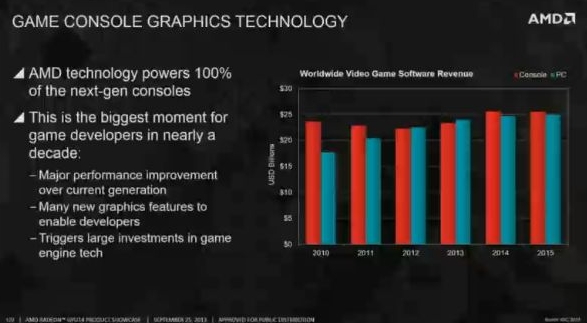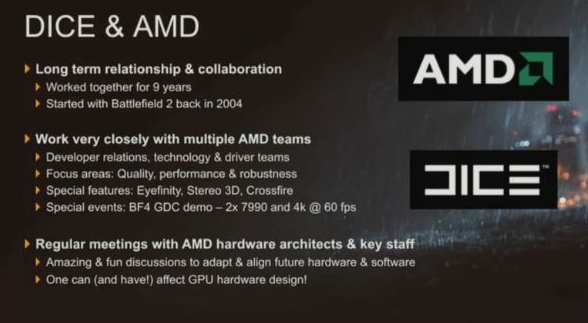But Mantle was for some reason reserved for the end of the presentation. So what’s the big deal about Mantle? Well AMD describes it as a low-level high-performance console-style graphics API for PC. That is a mouthful, but basically it is an API designed to tie in all AMD GCN products, which allows developers to speed up development for both consoles and PC titles. You can think of Mantle as the native language of GCN. This approach offers some very obvious advantages. With Mantle, AMD can leverage its console design wins and make development for all GCN products easier, from consoles, through APUs to Radeons and even FirePro cards.

AMD’s graphics guru Raja Koduri pointed out that Mantle also deliver massive performance gains, allowing devs to tap more power from GCN. In some cases, it could result in a nine-fold boost, practically bringing 2018-level performance to current generation graphics hardware.
Of course, to put theory into practice AMD needs support from all sorts of developers. DICE is the first company to support Mantle with its Frostbite 3 engine. Battlefield 4 will support Mantle as of December, allowing us to see whether AMD’s promises will live up to real world tests.

Frostbite 3 will render natively with Mantle on Windows, dropping DirectX 11 in favour of AMD’s new API. AMD says Mantle will allow perfect parallel rendering and allow the system to use all eight CPU cores. It will also deliver low CPU overhead rendering and avoid bottlenecking the GPU. On the GPU side, it will provide developers with full access to graphics hardware and allow them to come up with lots of low-level optimisations.

It is still too early to pass judgment, but Mantle looks very promising. It will take a couple of years before we see what AMD manages to make off it, but if it gains enough support from developers it could be a very big deal indeed. It looks like a win-win proposition for everyone other than Nvidia. Mantle should make developers’ lives a bit easier, while at the same time providing AMD hardware with a significant performance boost.
Notice that we said hardware – not GPUs. In fact, the CPU bit shouldn’t be overlooked. AMD appears to have gone to great lengths to put eight-core processors to good use, which is hardly surprising as new consoles feature eight AMD x86 cores. But on the PC side, this could also make AMD’s relatively affordable FX-series parts a lot more appealing to gamers.




